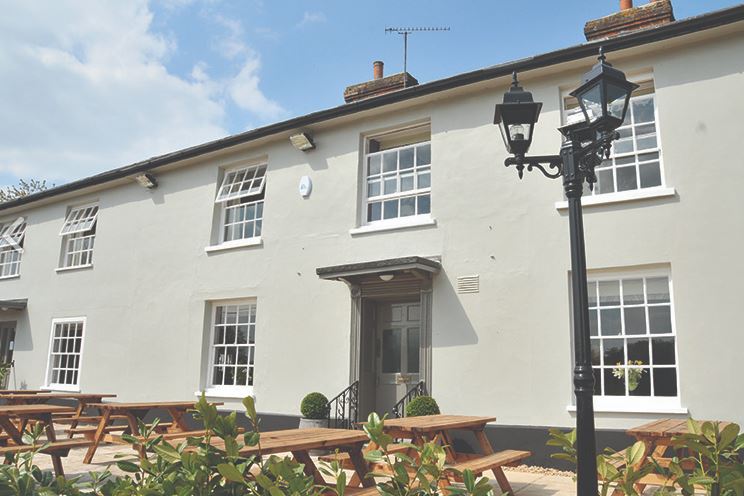This 750-year-old hotel is full of character, with a mix of bedrooms and suites; The Seamstress…
Historic Old Sarum

6.25 miles (10.1kms)
About the walk
Set on a bleak hill overlooking modern-day Salisbury (New Sarum) stand the massive, deserted ramparts and earthworks of the original settlement of Old Sarum. People have lived on this windswept hilltop for some 5,000 years – the outer banks and ditches were constructed during the Iron Age to create a huge hill-fort. It was later inhabited by the Romans and several Roman roads converge on the site. The Saxons followed and developed a town within the prehistoric ramparts.
The rise of Christianity
Soon after the Conquest, the Norman invaders realised the camp's strength and built the inner earthworks. Within the massive hilltop defences they built a royal castle, two palaces and, in 1075, Bishop Osmund constructed the first cathedral. The imposition of Norman rule had a profound effect on English society, in particular upon the Church, remodelling its structure, giving a new impetus to the building or reconstruction of parish churches and encouraging the development of new monasteries and other religious institutions. Nowhere is this more evident than at Old Sarum. Osmund's cathedral set new standards which were widely adopted in other English cathedrals. Instead of being run on monastic lines, it was served by 36 canons living in separate lodgings under the direction of four officers. The architecture was Romanesque and characterised by its lavish scale. Following Osmund's death in 1099, Bishop Roger was responsible for the ambitious rebuilding of the cathedral soon after 1100.
Old Sarum rapidly developed and for 150 years it was a thriving medieval city. As the cathedral grew more powerful, friction developed between the clergy and the military governor of the castle at Old Sarum. After Roger's death in 1139, the city went into decline and quarrelling increased between the two powers. The vitality and wealth of the Church, combined with the exposed site, lack of space to expand the cathedral and the shortage of water at Old Sarum, led to the removal of the cathedral to a new city by the River Avon in the early 13th century. Building work on the new cathedral began in 1220 and was largely completed by 1250.
The castle remained in use until Tudor times and was one of the most notorious rotten boroughs in the country when in 1832, only 10 voters returned two Members of Parliament; one was William Pitt the Elder, Prime Minister from 1766 to 1768. Today, it is deserted and you can roam across the 56 acres (22.6ha) of ramparts and ruins, admiring the Avon Valley views. A fee is charged to view the inner bailey ruins.
Walk directions
From the car park, walk down the access road through the outer bank of the fortified site. Bear left, then, as the road bends right, go through the two gates leading to a waymarked and fenced bridle path and follow this until you reach a road.
Go through the gate opposite and follow the track ahead. Pass a cottage (Shepherds Corner) and ascend the track. In 0.25 miles (400m), descend to Keeper's Cottage and a crossing of paths.
Keep straight on, heading uphill and between fields into a wooded area. At a crossing of bridle paths, turn left and descend a tree-lined path. Follow the path down to farm buildings and continue to a road.
Turn left, then right in 50yds (46m) down a metalled lane. Cross the River Avon and two further footbridges, then follow the metalled path and drive to a road. Turn left for The Wheatsheaf Inn; otherwise, turn right and in 50yds (46m) turn left up a lane.
Just before cottages and barns, turn left through a kissing gate and walk down the left-hand field-edge. Go through another kissing gate, then ahead and over a stile. Walk on beside a hedge. At the edge of a field, by a permissive footpath, maintain direction across a field, cross a track and go straight on. Continue on this line, through a hedge gap, to meet the road on your left, by a footpath sign.
Cross the road diagonally and take the path down a wooded track. Pass to the left of 'The Bays' to a stile and turn right between the stream and fence. Cross double stiles in the corner and turn sharp left over a stile and turn right beside the stream to a small gate and a metalled drive. Turn left and skirt Home Farm and Little Durnford Manor to an electronic gate (green button on right) and road.
Turn right and follow the road for 0.75 miles (1.2km) to a staggered crossroads. Keep ahead towards Salisbury, crossing the stile on your left in 100yds (91m). Bear half left across the field, then skirt the churchyard to reach a stile, a metalled path and a further stile. Head down the next field, cross a stile and keep right of a barn, then cross a stile on a fenced track.
Meet a track and turn left uphill towards the tree-covered ramparts. Keep left at the junction of paths by a gate, then fork right through a gate and climb on to the outer rampart. Go through a gate, turn right and follow the path to a gate and Old Sarum's access road. Turn left back to the car park.
Additional information
Footpaths, tracks, bridle paths, stretches of road, many stiles
Downland, river valley, castle ramparts
Keep dogs on lead at all times
OS Explorer 130 Salisbury & Stonehenge
Old Sarum car park (English Heritage); closes 6pm, 3–4pm winter
Old Sarum car park (free)
WALKING IN SAFETY
Read our tips to look after yourself and the environment when following this walk.
Find out more
Also in the area
About the area
Discover Wiltshire
A land shrouded in mystery, myth and legend, Wiltshire evokes images of ancient stone circles, white chalk horses carved into hillsides, crop circles and the forbidden, empty landscape of Salisbury Plain. To many M4 and A303 drivers heading out of London through the clutter of the Thames Valley, Wiltshire is where the landscape opens out and rural England begins.
Wiltshire’s charm lies in the beauty of its countryside. The expansive chalk landscapes of the Marlborough and Pewsey downs and Cranborne Chase inspire a sense of space and freedom, offering miles of uninterrupted views deep into Dorset, Somerset and the Cotswolds. Wiltshire’s thriving market towns and picturesque villages provide worthwhile visits and welcome diversions. Stroll through quaint timbered and thatched villages in the southern Woodford and Avon valleys and explore the historic streets of the stone villages of Lacock, Castle Combe and Sherston. Walk around Salisbury and discover architectural styles from the 13th century to the present and take time to visit the city’s elegant cathedral and fascinating museums. And if all of that isn’t enough, the county is also richly endowed with manor houses, mansions and beautiful gardens.
Nearby stays
Restaurants and Pubs
Nearby experiences
Recommended things to do
Why choose Rated Trips?
Your trusted guide to rated places across the UK
The best coverage
Discover more than 15,000 professionally rated places to stay, eat and visit from across the UK and Ireland.
Quality assured
Choose a place to stay safe in the knowledge that it has been expertly assessed by trained assessors.
Plan your next trip
Search by location or the type of place you're visiting to find your next ideal holiday experience.
Travel inspiration
Read our articles, city guides and recommended things to do for inspiration. We're here to help you explore the UK.

















